
Silesian Voivodeship is a voivodeship, or province, in southern Poland centered on the historic region known as Upper Silesia, with Katowice serving as its capital.

Masovian Voivodeship or Mazowieckie Province or Mazowieckie Voivodeship or Mazovian Voivodeship or Mazovian Province, etc. is a voivodeship (province) in east-central Poland, containing Poland's capital Warsaw.

Dąbrowa Górnicza is a city in Zagłębie Dąbrowskie, southern Poland, near Katowice and Sosnowiec. It is located in eastern part of the Silesian Voivodeship, on the Czarna Przemsza and Biała Przemsza rivers.

Świętokrzyskie Voivodeship, also known as Holy Cross Voivodeship, is a voivodeship (province) in southeastern Poland, in the historical region of Lesser Poland. The province's capital and largest city is Kielce.

Lublin Voivodeship is a voivodeship (province) of Poland, located in the southeastern part of the country, with its capital being the city of Lublin.

Lubartów is a town in eastern Poland, with 23,000 inhabitants (2004), situated in Lublin Voivodeship. It is the capital of Lubartów County and the Lubartów Commune. Historically it belongs to Lesser Poland.

Zawiercie ( ) is a town in southern Poland located in the Silesian Voivodeship with 49,334 inhabitants (2019). It is situated in the Kraków-Częstochowa Upland near the source of the Warta River. The town lies near the historical region of Silesia, but belongs to Lesser Poland.

Parczew is a town in eastern Poland, with a population of 10,281 (2006). It is the capital of Parczew County in the Lublin Voivodeship.
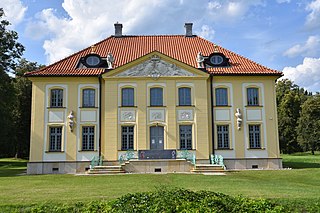
Choroszcz is a town in north-eastern Poland, located in Białystok County, Podlaskie Voivodeship, seat of Gmina Choroszcz.
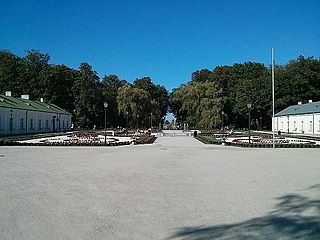
Końskie is a town in south-central Poland with 20,328 inhabitants (2008), situated in the Świętokrzyskie Voivodeship. Historically, Końskie belongs to the province of Lesser Poland, and since its foundation, until 1795, it was part of Lesser Poland's Sandomierz Voivodeship.

Starachowice is a city in southeastern Poland, with 49,513 inhabitants (31.12.2017). It is the capital of Starachowice County in the Świętokrzyskie Voivodeship. It is situated upon the River Kamienna, a tributary of the Vistula River, among hills and forests.
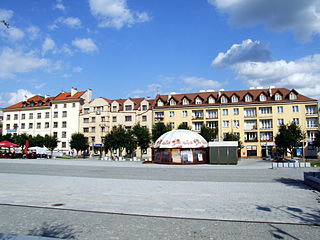
Ostrowiec Świętokrzyski, often referred to as Ostrowiec, is a city in southeastern Poland, in the historical region of Lesser Poland, with 66,258 residents. The town is one of the historic centers of Polish industry and metallurgy, and was part of the Old-Polish Industrial Region, the oldest industrial basin of the country.

Janów Lubelski is a town in southeastern Poland. It has 11,938 inhabitants (2006). Situated in the Lublin Voivodship, Janów Lubelski belongs to Lesser Poland, and is located in southeastern corner of this historic Polish province. It is the capital of Janów Lubelski County. It has a large hospital. It also has several tourist attractions, including buildings and churches from the 17th and 18th centuries. Janów Lubelski is home to the Open-air museum of the Forest Railway in Janów Lubelski

Ogrodzieniec is a town in Zawiercie County, Silesian Voivodeship, Poland, with 4,282 inhabitants (2019). It is noted for the extensive ruins of a medieval castle.

Żarki is a town in Myszków County, Silesian Voivodeship, Poland, with 4,556 inhabitants (2019). The history of Żarki dates back to the early 14th century, as the village was first mentioned in documents from the 1320s. For centuries, Żarki belonged to Lelow County, Kraków Voivodeship, historic province of Lesser Poland.
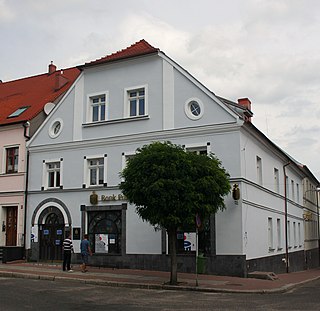
Międzychód is a town in Greater Poland Voivodeship, Poland, the administrative seat of Międzychód County. It is located on the southern shore of the Warta river, about 75 km (47 mi) west of Poznań. Population is 10,844 (2010).
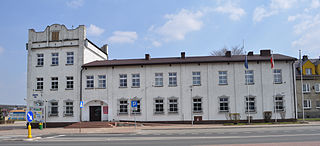
Blachownia is a town in Częstochowa County, Silesian Voivodeship, Poland. It lies about 10 km (6.2 mi) west of the city of Częstochowa. The town belongs to historic Lesser Poland. As of December 2021, it has a population of 9,383.
Old Polish Industrial Region is an industrial region in northern part of Lesser Poland. It is the oldest and in terms of area covered, largest of Polish industrial regions. Most of the region is located in Lesser Poland Upland, and its historic center lies along the Kamienna river. Primary industrial cities: Kielce, Radom, Ostrowiec Świętokrzyski, Starachowice and Skarżysko-Kamienna.

Radoszyce is a town in Końskie County, Świętokrzyskie Voivodeship, in south-central Poland. It is the seat of the gmina called Gmina Radoszyce. It lies approximately 19 kilometres (12 mi) south-west of Końskie and 33 km (21 mi) north-west of the regional capital Kielce.
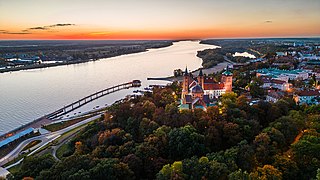
Mazovia or Masovia is a historical region in mid-north-eastern Poland. It spans the North European Plain, roughly between Łódź and Białystok, with Warsaw being the unofficial capital and largest city. Throughout the centuries, Mazovia developed a separate sub-culture featuring diverse folk songs, architecture, dress and traditions different from those of other Poles.






















